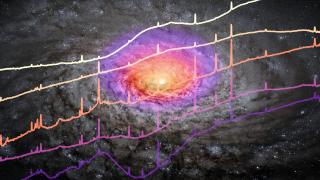Bibcode
Laloux, Brivael; Georgakakis, Antonis; Alexander, David M.; Buchner, Johannes; Andonie, Carolina; Acharya, Nischal; Aird, James; Alonso-Tetilla, Alba V.; Bongiorno, Angela; Hickox, Ryan C.; Lapi, Andrea; Musiimenta, Blessing; Ramos Almeida, Cristina; Villforth, Carolin; Shankar, Francesco
Referencia bibliográfica
Monthly Notices of the Royal Astronomical Society
Fecha de publicación:
8
2024
Número de citas
13
Número de citas referidas
11
Descripción
We adopt a Bayesian X-ray spectral approach to investigate the accretion properties of unobscured ($20\lt \log (N_{\rm H}/{\rm cm}^{-2}\lt 22$) and obscured ($22\lt \log (N_{\rm H}/{\rm cm}^{-2}\lt 24$) active galactic nuclei (AGNs) to shed light on the orientation versus evolution scenarios for the origin of the obscuring material. For a sample of 3882 X-ray-selected AGN from the Chandra COSMOS Legacy, AEGIS, and CDFS extragalactic surveys, we constrain their stellar masses, $M_\star$, intrinsic X-ray luminosities, $L_{\rm X}$, obscuring column densities, $N_{\rm H}$, and specific accretion rates $\lambda \propto L_{\rm X}/M_\star$. By combining these observables within a Bayesian non-parametric approach, we infer, for the first time, the specific accretion rate distribution (SARD) of obscured and unobscured AGN to $z\approx 3$, i.e. the probability of a galaxy with mass $M_\star$ at redshift z hosting an AGN with column density $N_{\rm H}$ and specific accretion rate $\lambda$. Our findings indicate that (1) both obscured and unobscured SARDs share similar shapes, shifting towards higher accretion rates with redshift, (2) unobscured SARDs exhibit a systematic offset towards higher $\lambda$ compared to obscured SARD for all redshift intervals, (3) the obscured AGN fraction declines sharply at $\log \lambda _{\rm break} \sim -2$ for $z \lt 0.5$, but shifts to higher $\lambda$ values with increasing redshift, (4) the incidence of AGN within the theoretically unstable blow-out region of the $\lambda -N_{\rm H}$ plane increases with redshift. These observations provide compelling evidence for AGN 'downsizing' and radiation-regulated nuclear-scale obscuration with an increasing host galaxy contribution towards higher redshifts.
Proyectos relacionados

Actividad Nuclear en Galaxias: una Perspectiva 3D del Núcleo y su Entorno
Nuestro proyecto puede dividirse en dos líneas principales de investigación. En primer lugar, el estudio de los vientos producidos por cuásares luminosos oscurecidos y del impacto que estos tienen en sus galaxias anfitrionas (retroalimentación del AGN). Para ello hemos obtenido observaciones en el óptico e infrarrojo cercano con el Gran Telescopio
Cristina
Ramos Almeida